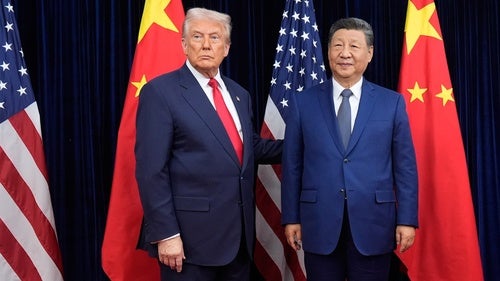How Trump's Improvisational China Policy Is Impacting Trade, Taiwan, and Strategic Competition

The recent Trump-Xi meeting resolved none of the underlying tensions between Beijing and Washington. It merely kicked the can down the road.
US President Donald Trump’s October meeting with Chinese President Xi Jinping in Busan, South Korea, was hailed as a major breakthrough by the Trump administration and presented as the advent of a productive new era in US-China relations. Trump himself described the meeting on the Truth Social platform as “a great one for both of our countries” that “will lead to everlasting peace and success.” Many analysts and commentators, however, have said the meeting achieved little more than a negotiated truce in Trump’s trade war with Beijing.
Primarily in exchange for Trump’s suspension of a pending increase in tariffs on China, Xi agreed to suspend pending export controls on rare earths, increase Chinese purchases of US soybeans, and enhance efforts to curtail exports from China of chemical precursors for the deadly drug fentanyl. But this temporary truce resolves none of the underlying tensions or competition between the United States and China. It merely kicks the can down the road, leaving the relationship no more insulated against disputes and crises than it was before.
One potentially constructive aspect of the Trump-Xi meeting was the implicit US recognition of the constraints imposed on Washington by China’s relative global clout. Beijing’s willingness to threaten retaliation for US tariffs and export restrictions by wielding its own economic levers underscores the interdependence of the two countries—and the fact that China is well-equipped to fight fire with fire. Washington has long overestimated its power over China and underestimated Beijing’s leverage over the United States. A more accurate and up-to-date understanding of the balance of economic power is overdue and will be important going forward. But it remains unclear whether the Trump administration is fully prepared to acknowledge this new dynamic and incorporate it into Washington’s strategy and tactics toward China.
Trump’s initial readout on Truth Social of his meeting with Xi outlined the concessions made by the Chinese side but notably made no mention of those made by Washington, which included a pause in US port fees in addition to lowered tariffs on Chinese imports. Although reciprocal engagement and some level of mutual accommodation is necessary to deescalating bilateral tensions and putting US-China relations on a constructive path, the Trump administration does not appear inclined to accept the domestic political risks of admitting this or further operationalizing it in its approach to Beijing.
"Although reciprocal engagement and some level of mutual accommodation is necessary to deescalating bilateral tensions and putting US-China relations on a constructive path, the Trump administration does not appear inclined to accept the domestic political risks of admitting this or further operationalizing it in its approach to Beijing."
Perhaps more fundamentally, it is not at all clear what principles, goals, or strategies are driving Trump’s personal approach to China. He clearly is not motivated by the “democracy versus autocracy” theme of President Joe Biden and his administration, partly because Trump is not an ideologue and partly because he apparently has no aversion to autocracy. Nor has Trump demonstrated in any coherent or reliable way that he is a grand strategist or is even capable of strategic thinking. Instead, his record is that of a transactional, impulsive, and willfully unpredictable statesman who believes that his personal relationships—like the one he claims to have with Xi on the basis of episodic interactions—can secure US interests and advance US objectives. So far, this has not yielded a consistent or sustained China policy.
Trump’s scattershot approach is exemplified by his pronouncements on the Taiwan issue. He has alternated between dismissing Taiwan as strategically incidental or irrelevant and acknowledging its importance as an economic player, especially as the producer of most of the world’s semiconductors. As a result, Trump has kept both Taiwan and its US supporters guessing about the depth of his attention to the longstanding US commitment to Taiwan’s security.
In conversations about the “one China policy,” Trump has displayed a limited understanding of its meaning or its history. He also claims that Xi has assured him that China will not attack Taiwan during his presidency. Most China specialists judge that Xi almost certainly would never have made such a statement, at least not seriously. Trump’s claim that Xi did suggests that Trump has a similarly limited understanding of the Chinese mindset on the Taiwan issue.
In another illustration of his strategic recklessness on China, Trump referred to his session with Xi as a “G2 meeting,” invoking a notional concept of US-China joint global governance that was in circulation over a decade ago. Trump appears to be inattentive to (or ignorant of) the fact that Beijing, Washington, and most US allies all rejected the G2 idea for different reasons. It thus is not clear if he understood what he was talking about and why he thought the concept still had appeal or relevance. These may be minor rhetorical incidents, but they underscore Trump’s improvisational style of policymaking and policy declaration.
So, how is one to know what to expect from Trump on issues related to or involving China? That is probably an open question even within his own administration. Many Republican so-called China hawks joined Trump’s administration as a vehicle for their determination to expand and accelerate the strategic contest with Beijing, based on their judgment that China poses an existential threat or zero-sum competitive challenge to the United States. It remains unclear whether Trump himself shares that assessment or that agenda, and even if he can be relied upon to support them rhetorically or substantively. It is also not clear if the China hawks reflect a working-level consensus within the Trump administration on how to deal with Beijing. In short, it might be many months before a coherent, cohesive, and consistent China strategy begins to emerge from the White House.
What is clear—given this uncertainty on the US side—is that Beijing itself has little reason to expect regularity or reliability in Trump’s approach to China, at least in the near term. Accordingly, Xi will be cautious about investing in any assurances and commitments he receives from Trump. In the meantime, Trump’s improvisational, scattershot approach will be competing with Xi’s much more coherent and cohesive strategy—that of defending Beijing’s core principles and maximizing China’s wealth, power, and influence relative to that of the United States.


